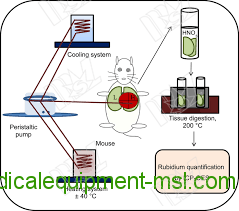Analyze samples by ICP-OES
To analyze a sample, scientists need a way to interact with it and record the results. One of the easiest ways - and one of the oldest - comes from lighting up it and seeing what is visible to the naked eye. To interact more directly with the sample, scientists not only saw it bright enough, for example, inductively coupled plasma (ICP) can be used to push some of the electronic samples to the higher shell, excite them, and with The electron falls back to its normal position, causing the ionizing electromagnetic radiation. This stimulus can be analyzed by Optical Emission Spectroscopy (OES), which can be used in many ways.
The application of ICP-OES covers a wide range of research areas, one of which is food science. Here, ICP-OES can be used to analyze contaminants such as arsenic in foods or metals in wine. Hazardous chemicals can sometimes bind trace proteins, ICP-OES can analyze traces, and ICP-OES can also analyze this. If the soil lacks any critical nutrients; if so, increase the proper type and amount of fertilizer.
In fact, ICP-OES is as widely used and widely used as chemicals. Mineralogists can use ICP-OES to analyze gems, which automotive experts can apply to engine oils to determine the wear and tear on engine components - expressed as traces of metal or other contaminants or components. At Portland State University's Geological Laboratory, laboratory technician Alexandra Franco provided evidence of the variety of sample types that can be used with ICP-OES. "We used ICP- OES analyzes water samples, digests soil and digests rock samples. "
However, ICP-OES must be established in the most effective way to achieve these critical analyzes. The key part is optics.
Intermediate Optics
When the sample contains an argon-based ICP activator, the features in the light can be extracted to identify the components. The diffraction grating separates the emitted light in the detector quantified spectrum. The result is an elemental fingerprint of the sample.
In most ICP-OES platforms, the middle-order rasters provide diffraction. These create an array of two-dimensional results consisting of short segments arranged in IR (infrared) to ultraviolet (UV). This step-like appearance explains the name "middle-order optics" from the French ladder or ladder.
These rasters use low groove densities from light and high angles of incidence to provide higher diffraction orders, placing more spacing between the lines at the detector. Since the late 1990's, middle-stepped rasters have been used in a variety of ways by the 1920s and beyond.
Despite the tradition of these gratings, they still require a fair amount of optics for ICP-OES. In particular, most platforms require several other components - mirrors, prisms, and possibly cross diffusers. This can really reduce the light from the sample to the detector. In some cases, each optical surface can remove up to 15% of the light and maybe more in the UV range.
ORCA Optics
Alternatively, some ICP-OES platforms replace the medium-sized rasters with optimized ORCA technology. The ORCA technology is not a two-dimensional detector used with a middle-stepped grating, but includes a series of charge coupled devices (CCDs). In addition, this technique reduces the amount of light lost by the curved mirror. These are as much light as possible on the CCD detector.
In general, ICP-OES with ORCA technology provides high sensitivity and similar resolution over a wide spectral range. Technology is also stable. This portfolio of technologies can be found on various SPECTRO Analytical Instruments platforms, including the ARCOS, GENESIS and SPECTROBLUE ICP-OES analyzers.
For example, ARCOS covers wavelengths of 130-770 nanometers and captures the complete spectrum of the sample within 4 seconds. The platform also includes 32 line detectors.
Scientists at Rutgers University used crayfish from the Hudson River using the SPECTRO GENESIS ICP-OES.1 In particular, the researchers investigated whether this organism contains PGMs, including palladium, platinum and rhodium. They explained: "In this study, native Orderstone virilis was used as a model to study the effects of PGM on bioaccumulation and histopathological changes." The researchers exposed crayfish to a range of PGM concentrations - From 0 to as much as ten parts per million for a period of 10 days. They then used SPECTRO GENESIS to analyze the metal in the samples, including exoskeletons, liver and nervous system tissues. The results show a statistically significant increase in PGMs in all tissues, and some even include visual evidence of structural damage. For example, scientists point out that "the exoskeleton shows a visible band in appearance, indicating demineralization," and "extensive cerebral vacuolation of the brain and ganglia." This work simply outlines some of the uses and capabilities of this technology.





 Price is 8-20% Lower Than Other
Price is 8-20% Lower Than Other






